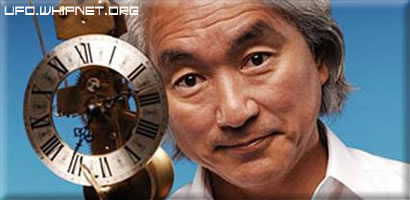Mainstream Scientist Believes in Extraterrestrials

Mar.14.2007
Dr. Michio Kaku (born in the United States) is a Japanese American theoretical physicist, tenured professor, and co-founder of string field theory, a branch of super-string theory.
While it is the belief by many that mainstream scientists reject any notions of extraterrestrial civilizations or aliens, Kaku is very unique. Not only does he believe in ETs, he also lays down a framework for their existence in his numerous books.
The probability is very high that not only do a few alien civilizations exist, but many. Kaku in his book Hyperspace compares humans as fish in a pond, only aware of the environment around them, not realizing there is a huge world outside the pond. In an article at his website Kaku had this to say in regards to Carl Sagan, another believer in alien civilizations: The late Carl Sagan once asked this question, “What does it mean for a civilization to be a million years old? We have had radio telescopes and spaceships for a few decades; our technical civilization is a few hundred years old… an advanced civilization millions of years old is as much beyond us as we are beyond a bush baby or a macaque.”
This answers the question that many debunkers have raised for years. For years they have asked why aliens don’t just announce their presence, or land in Times Square.
The reason that they will not do this is because if you are dealing with beings that are tens of thousands of years ahead of us, even millions, they would not be interested in us. Are you interested in an ant while you walk down the street?
Would you try to explain to a dog how to perform a complex equation? Most likely you would not, because a dog would not be capable of comprehending it. Now imagine an advanced civilization that are thousands of years ahead of us. See my point?
Kaku lays down a framework of levels of civilizations. Type 1, Type 2, and Type 3. Here are the descriptions of a civilization at these three levels.
Physics of Type I, II, and III Civilizations
Specifically, we can rank civilizations by their energy consumption, using the following principles:
1) The laws of thermodynamics. Even an advanced civilization is bound by the laws of thermodynamics, especially the Second Law, and can hence be ranked by the energy at their disposal.
2) The laws of stable matter. Baryonic matter (e.g. based on protons and neutrons) tends to clump into three large groupings: planets, stars and galaxies. (This is a well-defined by product of stellar and galactic evolution, thermonuclear fusion, etc.) Thus, their energy will also be based on three distinct types, and this places upper limits on their rate of energy consumption.
3) The laws of planetary evolution. Any advanced civilization must grow in energy consumption faster than the frequency of life-threatening catastrophes (e.g. meteor impacts, ice ages, supernovas, etc.). If they grow any slower, they are doomed to extinction. This places mathematical lower limits on the rate of growth of these civilizations.
Kaku defines a Type 1 civilization as one that is truly a planetary society, who has mastered all forms of terrestrial energy. Their energy output is much greater than ours. It would take at least 3,200 years to reach Type 2.
A Type 2 civilization is a civilization who have an energy output of a small star. They would be so advanced that they could build a sphere around their planet to maximize their energy output.
A Type 3 civilization is so advanced that they have begun colonizing other star systems. Their energy output is massive compared to ours. A civilization this advanced would be able to bend space and time at will. They would probably be capable of interdimensional travel and even time travel.
So where are we here on planet Earth? Well, we are Type 0. We still get our energy from dead plants. Pretty pathetic, if you ask me. I could only imagine what an advanced alien civilizations thinks of us. With our racism, wars, and class struggles we will be luck if we ever get to a Type 1. At the current rate, in my opinion the human race is headed toward extinction.
~~~~~~~~~~~~~~~~~~~~~~~~~~~~~~~~~~~~~~~~~~~~~
Kaku attended Cubberly High School (now closed) in Palo Alto, California where he was known as Mike Kaku and played first board on Cubberly's chess team around 1963. During this time, he had been experimenting heavily in his parents' garage. This attracted the attention of famous physicist Edward Teller, who took Kaku as a protégé. Kaku received a B.S. (summa cum laude) from Harvard University in 1968 where he came first in his physics class. He went on to the Berkeley Radiation Laboratory at the University of California, Berkeley and received a Ph.D. in 1972. In 1973, he held a lectureship at Princeton University.
Dr. Kaku was drafted and entered the U.S. Army as an infantryman. He completed basic training at Fort Benning, Georgia, but the Vietnam War ended before he was to be shipped out.
Currently he holds the Henry Semat Chair and Professorship in theoretical physics at City College of New York, where he has taught for more than 25 years. Presently, he is engaged in working on "Theory of Everything," seeking to unify the four fundamental forces of the universe: the strong force, the weak force, gravity and electromagnetism. Additionally, he has been a visiting professor at the Institute for Advanced Study in Princeton, as well as at New York University.
Dr. Kaku is the author of several scholarly, Ph.D.-level textbooks and has had more than 70 articles published in physics journals covering topics such as superstring theory, supergravity, supersymmetry, and hadronic physics (although he has not published an original research article in seven years). Based on the number of citations his work has received in the academic literature, Kaku has an h-index of 22.
|

